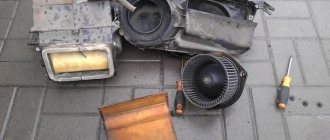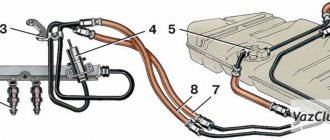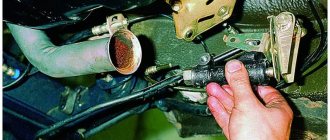Hi all. The cold weather has arrived, the long-awaited snow will soon fall in our region, and since last winter the stove has not suited me at all. Now you have the opportunity to drive your car into a spacious garage, time and desire, and what else do you need? Straight arms - available! Breaking is not building, so I dismantled this miracle of Russian engineering. The only problem arose when I started to pull out the torpedo - the iron cross member, which gives rigidity to the structure and holds the central frame, did not work:
For ease of installation and so as not to unscrew the steering column, I recommend using a chisel to separate this structure, as I showed in the photo above. Then there will be no problems with installation afterwards. At the spot welding joint there is a hole into which you can easily screw a bolt.
I washed it simply - I took it apart, raked out the centuries-old leaves, picked up laundry soap and a sponge and off I went. Be sure to dry it afterwards. While our plastic is drying, we pick up the element with the adjustments and disassemble it completely (don’t forget how it was initially, otherwise there is a chance of assembling it incorrectly). We clean it, then lubricate it with SILICONE grease (other grease hardens in the cold):
To optimize vehicle production and reduce their cost, AvtoVAZ uses the same components for models of different families. An example of such an assembly is the stove of the VAZ-2114 car, which belongs to the Samara-2 family. When designing this car, the interior heating system was borrowed from the models of the first Samara family - VAZ-2108-21099.
The VAZ-2114 stove is integrated, with heat intake from the engine cooling system and forced air circulation. Structurally, the interior heater of this car is simple, which has a positive effect on the reliability of the system.
The principle of operation of the heater cables on the VAZ 2114
The operation of a car's heating system is to transfer and redirect the heat that is released as a result of engine operation. Heat is removed by the cooling system and supplied, among other things, to the heater radiator. Then, when the switch is turned on (turned on), the heating system starts a motor that blows out hot air and passes it through the car panel deflectors. Air redirection to a particular area is carried out directly by the driver by switching the airflow positions.
When clicked, the picture enlarges
Most cases of stove malfunctions are associated with just one reason and this is the VAZ 2114 stove cable. The fact is that over time the tension of the cable weakens. This occurs as a result of its constant tension, weakening when moving the lever for adjusting the heating mode (cold and hot). There are also cases when the cable completely flies off the stove tap. As a result, the stove valve does not open completely, thereby you do not receive significant portions of hot air from the heating system.
What to do? To change or not to change? Here are the most common questions from car enthusiasts. Let's answer this: before replacing anything, you should find the cause of the malfunction and try to eliminate it.
Causes of insufficient heat
The ability to understand and feel a car means a lot. Some possible problems noticed in time can be easily eliminated by tuning. What can cause poor heating?
Firstly, the fan is not working. It's three speed. And if the fan does not work at any speed, then it should be replaced. The resistor could also be the culprit. When the fan starts working only at speed 3, replace the additional resistor.
Secondly, the thermostat. When the engine is running, the connecting pipe (thermostat - radiator) remains cold. Otherwise, you need another thermostat.
Thirdly, the filter is clogged. On older VAZ 2114 models there is no such filter. On new ones it is located under the heater casing. If he is the culprit, we need to install another one.
Don't let your filter get into this state.
Also, the cause of poor interior heating can be an air lock, insufficient or absent coolant in the expansion tank, the inability to fully open the heater tap, or a dirty radiator.
Diagnostics of the operation of the VAZ 2114 stove cables
In order to inspect the valve cable of the VAZ 2114 stove, you need to dismantle the side panel trim on the driver's side (to the right of the gas pedal). Further details:
- Start and warm up the car engine thoroughly.
- Unscrew the three side trim mounting bolts.
- Turn your gaze towards the heater valve.
- Check to see if the cable has come loose from the faucet.
- Move the heater lever on the instrument panel to maximum heating mode.
- Pull the cable towards you and hold it in this position
- Check if hot air is coming from the deflectors.
Now that the source of the problem has been identified. It is required to fix, give constant tension and thereby ensure good operation and correct throughput.
One of the options for increasing the tension is a method in which a part (0.5-1 centimeter) of the cable is bent at the point of direct connection to the heater lever. To do this you will need:
- Remove the second trim, only from the passenger seat side.
- Take pliers and pull the cable towards you (at this moment, the temperature switch should be at maximum heating mode).
- Bend the additional amount of cable formed (its amount is selected experimentally, and in each specific case it differs and, as a rule, amounts to 0.5 centimeters).
- We hook it up to the temperature switch of the stove.
Replacing heater cables on a VAZ 2114
Sometimes situations occur when, for one reason or another, the product becomes bent or even breaks off. Such cases require removing the device and replacing it with a new one. Recommendations for analysis are as follows:
- The metal clips that hold the cable in place must be disconnected.
- One end of the cable is connected to the tap, the other side to the lever for adjusting the air temperature in the cabin. Any sequence of disconnection can be followed. But it will be most convenient to first disconnect the end from the stove tap, unfasten all the clips and, last of all, disconnect it from the lever.
- Now the product should be carefully removed from the case.
- When reinstalling the new part, start by attaching it to the tap.
There are a lot of different models on the auto goods market that differ in length, thickness, various types, and shapes of both ends. In order not to make a mistake when purchasing a new product, we advise you to take it with you to the store. Usually cables are sold in one set of several pieces at once.
So we learned how to change the heater cables on a VAZ 2114. The most important thing when carrying out work is not to rush, to understand the principle of operation of the hot and cold air supply mechanism. We wish you warm heaters!)
A car uses many systems and mechanisms. One of them is the interior heating system. The VAZ-2114 is also equipped with it. Unlike an air conditioner, a stove is required in cars. After all, in the heat you can open the windows. But in winter you won’t be able to cope with the cold in the cabin without a stove. What does this element represent? How does the heating system of the VAZ-2114 work? The diagram, principle of operation and malfunctions are further in our article.
Deflectors for car windows and hood: installation and removal instructions
Deflectors on car windows and hoods are used everywhere. Most vehicles on the road are equipped with black or body-colored visors pasted over the sliding windows.
Some vehicles have a similar design in the front part of the hood. What are these devices used for? How to choose and install a deflector with your own hands?
Why are deflectors needed?
The structures under consideration have several functional purposes, which include:
- Protection of the hood from mechanical damage - a deflector mounted in the front part of the hood changes the direction of the air flow flowing around the car. Together with the upward flow, small stones and wheel spikes are diverted from the car, flying out from under the vehicle in front. In the absence of the so-called “fly swatters” all this ends up in the windshield of the car. In addition to the above, the deflector mechanically protects the edge of the hood from flying sand and dust.
- Protection of the windshield from insects - the direction of the oncoming flow changing under the influence of the device helps to remove mosquitoes and midges, which in warm weather literally stick to the windshields of cars that are not equipped with protective devices. Installing a fly swatter solves this problem.
- Improving the design of the car - visors and fly swatters significantly improve the appearance of most cars. Black elements look best when installed on light-colored cars.
- Protection from splashes in the cabin - a deflector on the car windows allows you to open them a little even in heavy rain. Of course, if the window is completely lowered, the device will not save you.
Criteria for choosing car deflectors
Installation of deflectors begins with their selection and purchase. It is necessary to select products based on several parameters. First of all, the visors must match the shape of the door or hood where they are planned to be mounted
It is important that the coincidence of all angles is accurate. Otherwise, the installed deflectors will not last long and will soon disappear
The second selection criterion is the method of attaching the products to the glass. There are plug-in and self-adhesive visors. Installing a hood deflector is always done in one way, so there is nothing to choose from.
The quality of a product is determined by its manufacturer. It is preferable to purchase goods from a monobrand manufacturer. However, devices of acceptable quality can also be sold by brands that develop several car models at once.
The most famous companies today are the following:
- Mono-brand (products for one brand of vehicle): climair, airpiex, heko.
- Multi-brand (products for several brands): autoclover, mobis.
- Little-known (not very common, usually Russian manufacturers): strelka, cobra, comfort.
Fly swatter installation procedure
Installing a fly swatter on the hood requires some knowledge. Violation of the installation technique leads to damage to the paintwork. The result is accelerated corrosion of the metal under the deflector.
Things to consider before installation
Before gluing the deflectors to the car, you should evaluate the condition of the hood edge.
Corroded areas should be cleaned, treated with a rust converter, puttied, primed and painted. The device should not be placed on rusty surfaces, as moisture almost always accumulates under the device. This will lead to the final destruction of the metal within several months.
The second factor to consider is the speed at which you plan to travel. On relatively low-speed vehicles, installation of deflectors can be carried out using adhesive tape or standard fasteners. For high-speed vehicles, additional fastenings should be made.
If installation is planned using glue or tape, the temperature in the room where the work is being carried out must be at least 10 °C. Otherwise, the fixing compounds will not stick to the paintwork and the deflector will fall off at the first shake. Installation using mechanical clips or bolts can be done at any temperature.
Characteristics and device
The main purpose of this system is to maintain optimal temperature in the cabin during the winter season. In addition to comfort, the stove is needed to prevent the windows, especially the windshield, from sweating. To prevent condensation from forming on it, special nozzles are provided at the top of the panel. However, first things first. Below is a diagram of the interior heating system:
- Water deflector shield.
- Windshield heating nozzle assembled with air ducts.
- Side nozzle designed for heating and ventilation of the interior.
- Central deflector.
- The heater is assembled with an electric motor.
- Interior ventilation nozzle.
- Stove tap seal.
- Rear heater pipe of VAZ-2114.
- Stove supply pipe.
How does it work
The principle of operation of the system is quite simple. It is based on the transfer of heat from a liquid. So, the heater radiator is connected to the main terminals of the engine cooling system. Inside the heat exchanger there is antifreeze or antifreeze. So, when the engine heats up, hot liquid flows in a “large” circle to the heater radiator. When the ACS (control unit) is turned on, the heater motor is activated. Warm air begins to move through the nozzles. The direction can be different - on the windshield, side, in the center of the cabin. One or more deflectors are activated, depending on the position of the stove lever.
That is, heat exchange occurs - hot antifreeze is cooled not only in the main radiator (which stands in front of the engine and is shown in the photo below), but also in the heat exchanger of the heating system.
The heater blows poorly into the legs and side windows
The heating system of the VAZ-2114 is not reliable. Over time, the stove stops heating the legs and side windows normally. Moreover, the problem is not in the temperature of the air (on the contrary, it can be hot), but in the strength of the flow with which it comes from the nozzles. In this case, you will have to modify the air flow channels. To do this, remove the front panel so that there is access to the nozzles.
FakeHeader
Comments 7
I cut a piece of metal from a nail of the same diameter and fused it into plastic))))
I thought about doing this too) what was the result? Doesn't the nail fall out over time?
No, that’s how the former Logan sold it, it seems to me that it turned out even stronger than the standard one, now I’ll have to do it on the Sander, otherwise passengers have a bad habit of twisting the deflector until the crap...))))
I should also try soldering a stud)
I cut a piece of metal from a nail of the same diameter and fused it into plastic))))
I don’t even understand where the carnation is and why?
There are 4 latches in the “curtains” of the deflector, reminiscent of some kind of pistons. They broke off from the author. This problem is common, and in order not to buy a new “flap”, a piece of nail similar in diameter and length is soldered into place of the broken piston
The overall impression of a car's interior is made up of little things. Only a set of measures to improve the interior make it truly attractive and unique. Let's consider one of these modifications, which concerns air duct deflectors and can significantly change the interior of the Lada Largus.










